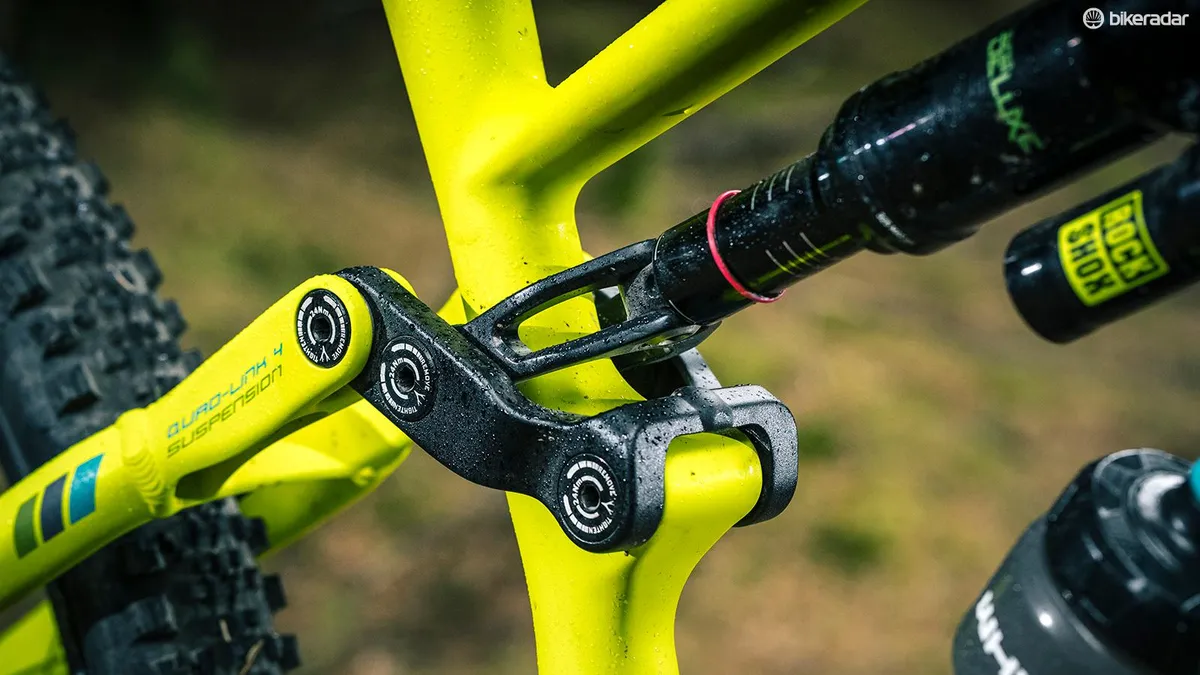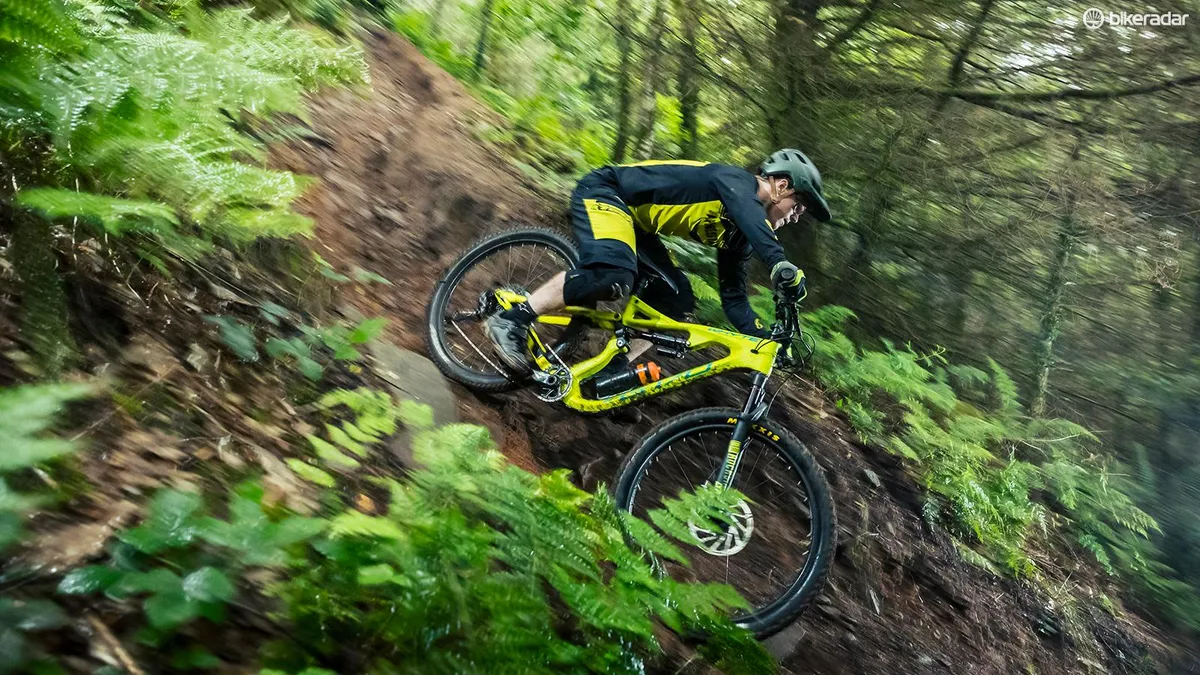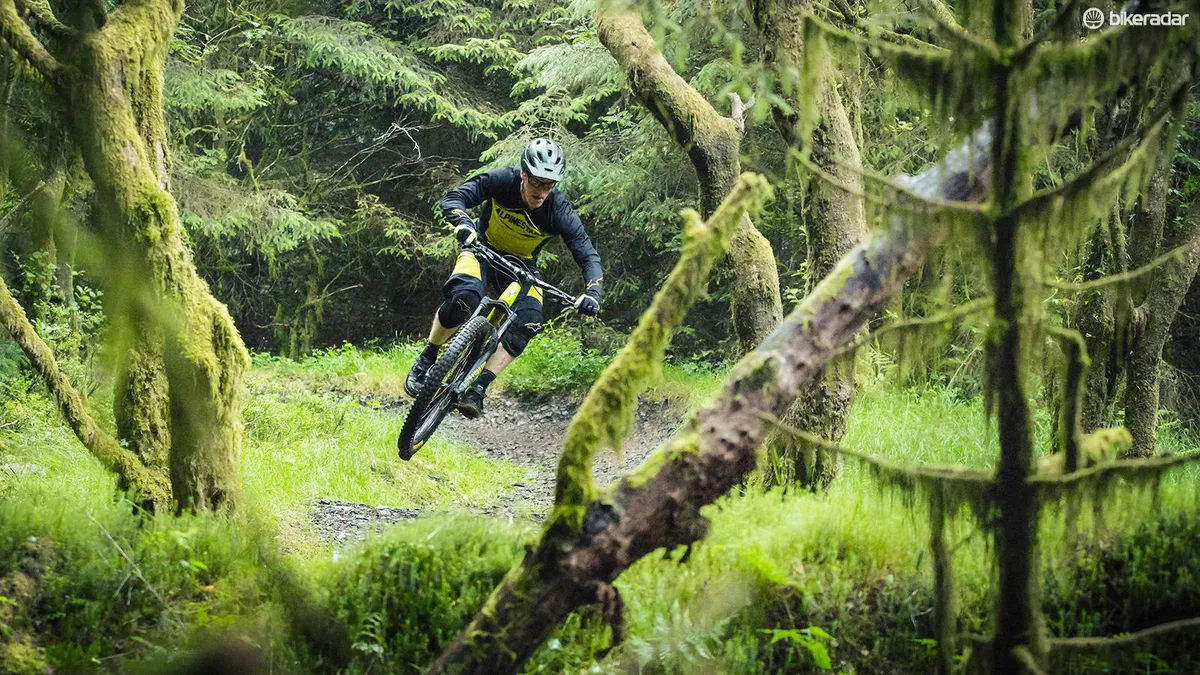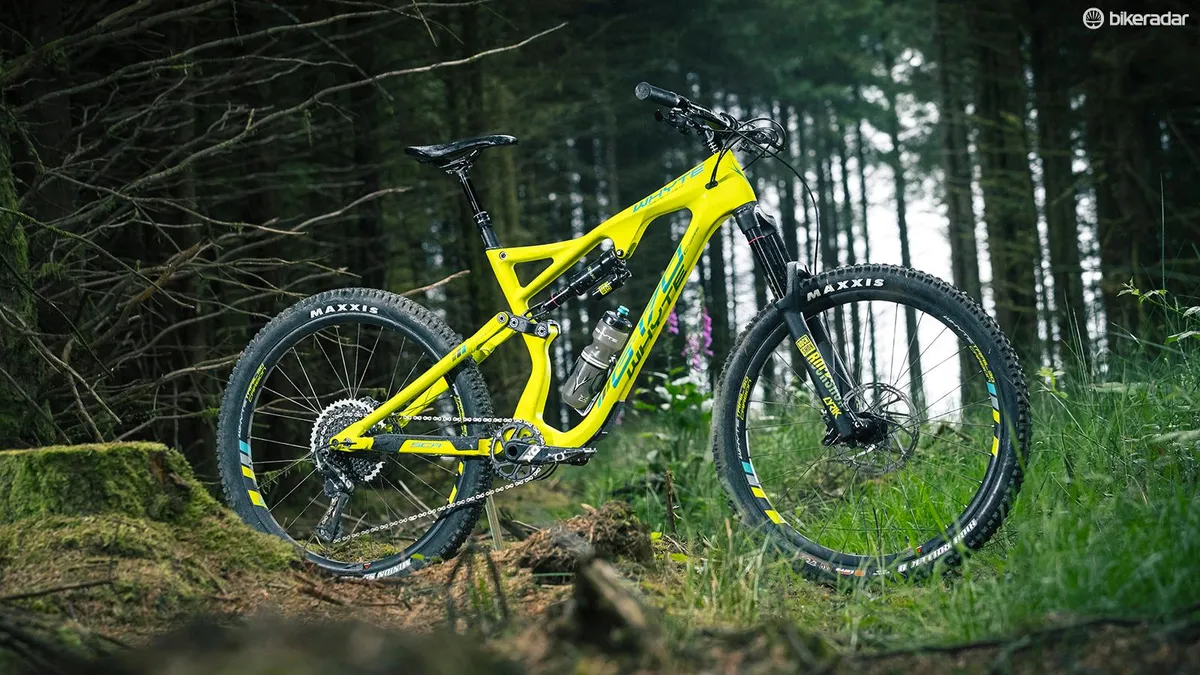The Whyte G-170 is designed to tackle the toughest trails around, up to and including any Enduro World Series race stage, and as the name suggests it boasts a whopping 170mm of travel front and rear, delivered via Whyte’s Horst-link platform.
The rear suspension linkage is pretty progressive, so it should work well with air and coil shocks alike, though all complete bikes come with air shocks as standard.
Tyre tactics
Unlike Whyte’s recently released S-150, which can accommodate 29" and 27.5” wheels, the G-170 is designed around 27.5” wheels only. Bikes will ship with 2.3/2.4” tyres, but boost spacing and huge tyre clearance affords the option to run up to 3.0” rubber front and rear.
Interestingly, Whyte’s design engineer and enduro shredder, Sam Shucksmith, has been experimenting with 2.8” rubber on his personal G-170, and, like us, found the fatter tyres allowed him to go faster on many of his local test tracks.

Geometry juggling
There’s no flip chip to adjust the geometry to suit different tyre sizes, fitting bigger rubber will simply result in a slightly higher bottom bracket; but as the stock bike comes with a super-low 333mm bottom bracket, that’s not necessarily a bad thing. In order to reduce the risk of pedal strikes, all bikes come with short 170mm crank arms.
The low BB is matched with a fairly slack 65-degree head angle to help boost high speed stability — that’s a full degree slacker than the outgoing G-160.

The holy trinity of low, slack and long continues with the pretty generous reach numbers. The Medium frame gets a 458mm reach, while the Large has 479mm. That’s pretty roomy, but weirdly, those numbers are a full size smaller than the old G-160 (a Large G-170 has a similar reach to a Medium G-160 and so on).
The slacker head angle and taller stack heights on the new bike mean the G-170’s front-centre length is still slightly longer, though, and the rear centre has grown by 5mm to 430mm to help balance out the long front end and get more weight on the front tyre.
The range and available sizes
There are three bikes in the G-170 stable: the S, the C RS and the C WORKS, costing £2,399 / $3,199 / AU$4,650; £3,799 / $4,799 / AU$6,999; and £5,499 / $6,499 / AU$8,999 respectively.
The cheapest S model uses a full alloy frame, SRAM 11-speed gearing and a RockShox Yari fork.
The two carbon models share the same alloy back end, but with a carbon mainframe. The RS model also boasts a Lyrik RC fork and SRAM GX Eagle 12-speed gearing.

The flagship WORKS model gains SRAM X01 Eagle transmission, Lyrik RCT3 fork and piggyback-equipped RockShox Syperdeluxe shock for better long-run consistency, as well as Whyte’s own carbon wheels.
The carbon models are only available in Medium and Large sizes, while the alloy bike comes in four sizes (Small to XL) so if you’re on the shorter or taller side only the alloy model will fit you.
At 6’3”, the size-Large WORKS bike I rode felt decidedly on the small side for me, and Whyte didn’t have any (alloy) XL bikes to test, so we’ll have to reserve judgement on ride impressions for now, but look out for a full review when we get one in to test.
In the meantime, we talked to Whyte’s design engineer, Sam Shucksmith, about some of the design decisions behind the G-170.
Five questions with Sam Shucksmith

BikeRadar: What’s the reasoning behind fitting short crank arms on the G-170 and S-150?
Sam: The crank length is 170mm on all sizes to allow for a lower bottom bracket height. I also find the short cranks more appropriate for the kind of pedalling you do on this kind of bike when it counts, half a crank in between obstacles.
BikeRadar: Can you tell me why you made the chainstay length a little longer on the G-170 compared to the G-160?
Sam: The G-160 received great reviews and many people (including at least one of BikeRadar’s testers) loved the shape, but it was generally considered that the rider weight distribution was skewed towards the rear due to the combination of short rear centre, long front centre and short stem. A rearward weight shift reduces front wheel grip and requires quite an extreme forward body position to achieve balanced fore/aft traction.
With the G-170 we wanted to centralise the rider’s centre of mass over the bike to achieve that all important weight distribution, whist assuming a more neutral body position. We tried various rear centre lengths and found that 430mm directed enough weight to the front wheel to keep it hooked up in turns, whilst not making the front too heavy and cumbersome to get it airborne when the urge presents!
BikeRadar: What's the logic behind making the reach (on paper) shorter on the 170 compared to the 160?
Sam: The changes to the reach and stack all fall into the pursuit of improved weight distribution between the wheels as discussed above. However if you consider the reach and stack together you will see that the cockpit length isn't much smaller. Also we have added an XL size [in the alloy model] for tall people, which we didn't have previously; it comes in slightly longer than the large G-160.
We have also compressed the seat tube length differences between sizes to allow people to size up or down without the seat tube being the limiting factor to fit.

BikeRadar: You say the G-170 is progressive and works well with a coil shock — how does the leverage curve compare to the G-160 and the S-150?
Sam: The G-170’s leverage curve is a smooth curve, from 3.1 - 2.2. The G-160 starts at 2.5, is progressive to 2.3, and then falls away to 2.7. The S-150 goes from 2.95 to 2.35. [The lower the leverage ratio, the firmer the suspension is, so a progressive curve starts with a higher number and ends with a lower one.]
We wanted the G-170 (and S-150) to be coil sprung compatible, which we have achieved here. There are some performance advantages we have found with coil springs. Most notably: the initial sensitivity, the second third support and enduring consistency. However these benefits come at the cost of quite considerable extra weight when compared with an air spring. For that reason, and the complication of providing the end consumer with the correct coil spring weight, we have specced the G-170 with air sprung dampers.
In terms of progression, you can pretty well achieve the same amount of sag and bottom out resistance with 0-1 air volume tokens as you get with the coil spring, hence compatibility with both spring types.
BikeRadar: I see you’re running 2.8” tyres on your personal G-170 whip — what testing have you done with plus tyres?
Sam: We found that 2.8" tyres can be faster in conditions and on surfaces that play to their strengths. Wide tyres struggle to dig in so don't work well on soft ground. But on hard rocky ground (like Afan), due to their ability to take a lower pressure whilst maintaining adequate casing tension, they grip really well and iron out the high frequency impacts resisting forward motion, which allows the wheels to roll faster.
Achieving the correct tyre pressure to balance trail chatter compliance and lateral stiffness is crucial, especially for heavier or more aggressive riders who push harder.
They are not for every condition though which is why we have specced narrower tyres... the tyre clearance is there though.

